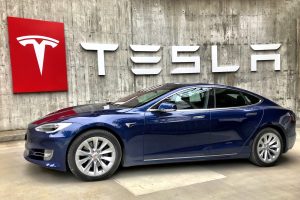In the rapidly evolving electric vehicle (EV) market, Tesla has long been the dominant force, driving innovation and setting benchmarks for performance and technology. However, as Tesla’s growth rate begins to decelerate, a new dynamic is emerging in the global EV landscape. For BYD, a major Chinese electric vehicle manufacturer, the significant challenge is not just from international competitors but from home-grown rivals. This article explores how the slowing momentum of Tesla affects BYD and examines the increasing threat posed by domestic competitors in China.
The Tesla Slowdown

Tesla’s remarkable rise has been marked by a relentless pace of innovation and market expansion. Yet, recent financial reports and market analyses indicate that Tesla’s growth trajectory is stabilizing. Several factors contribute to this slowdown:
- Market Saturation: Tesla’s primary markets, such as the United States and Europe, are becoming saturated. While Tesla continues to lead in EV sales, the incremental growth in these mature markets is slowing.
- Increased Competition: The EV market is becoming more competitive with numerous automakers, including established players and new entrants, intensifying the competition. This has led to a dilution of Tesla’s market share and reduced its ability to command a premium.
- Production Challenges: Tesla has faced various production issues, including supply chain disruptions and manufacturing delays, impacting its ability to meet demand and scale operations efficiently.
- Regulatory Pressures: As governments tighten regulations around emissions and safety, Tesla faces increased compliance costs and potential disruptions in its operations.
BYD’s Position in the Market
BYD (Build Your Dreams) has emerged as a formidable player in the global EV market. Founded in 1995, BYD has diversified its operations across automotive, battery, and renewable energy sectors. As Tesla slows, BYD’s position is strengthened by several factors:
- Strong Domestic Market Presence: BYD’s dominance in China, the largest EV market in the world, provides it with a substantial home-field advantage. This allows BYD to leverage local consumer preferences and regulatory support.
- Vertical Integration: BYD’s control over the entire EV supply chain, from battery production to vehicle assembly, provides cost efficiencies and resilience against supply chain disruptions.
- Innovative Technology: BYD continues to invest in research and development, pushing the boundaries of battery technology, autonomous driving, and vehicle design.
- Government Support: The Chinese government’s strong push towards green energy and subsidies for EVs significantly benefit domestic manufacturers like BYD.
The Growing Threat of Home-Grown Rivals
While Tesla’s deceleration presents an opportunity for BYD, the domestic competition in China is intensifying. Several key factors contribute to the rising threat from local rivals:
- Emerging Competitors: New entrants such as NIO, Xpeng, and Li Auto are gaining traction in the EV market. These companies are not only innovating rapidly but are also supported by substantial venture capital and government backing.
- Technological Advancements: Chinese EV manufacturers are making significant strides in technology, including advancements in battery technology, autonomous driving, and smart features. This puts pressure on BYD to continuously innovate to maintain its competitive edge.
- Consumer Preferences: As Chinese consumers become more sophisticated, their preferences are shifting towards newer and more advanced EV models. This poses a challenge for BYD to keep up with evolving market demands and preferences.
- Price Competition: Local competitors often engage in aggressive pricing strategies to capture market share. This can lead to price wars, which may erode profit margins for established players like BYD.
Analysis Table
| Factor | Tesla | BYD | Home-Grown Rivals |
|---|---|---|---|
| Market Saturation | High in primary markets (US, Europe) | Strong in domestic (China) | Moderate but growing |
| Innovation and Technology | Leading in many areas but facing slowing pace | Strong, with significant R&D investments | Rapidly advancing, competitive |
| Production Capability | Facing challenges with scaling and supply chain | Vertically integrated, robust production | Varies by company, but improving |
| Government Support | Moderate in US and Europe, changing regulations | High in China, strong subsidies | Varies, but generally supported in China |
| Consumer Preferences | Mature markets, high brand loyalty | Growing, with diverse offerings | Evolving, demanding advanced features |
| Competitive Pricing | Premium pricing model | Competitive pricing, but facing price pressure | Aggressive pricing strategies |
Comparative Table
| Aspect | Tesla | BYD | NIO | Xpeng | Li Auto |
|---|---|---|---|---|---|
| Founded | 2003 | 1995 | 2014 | 2014 | 2015 |
| Primary Market | Global, focus on US and Europe | China, expanding globally | China, expanding globally | China, expanding globally | China, expanding globally |
| Battery Technology | Advanced, but facing supply chain issues | Strong, vertical integration | Innovative, focus on range and charging speed | Advanced, focus on performance and range | Advanced, focus on range and technology |
| Vehicle Range | Extensive, with high-performance models | Diverse range, including affordable models | Competitive range with focus on luxury | Competitive range with focus on technology | Competitive range with focus on technology |
| Price Range | Premium to high-end | Broad, from affordable to high-end | Premium to luxury | Mid-range to premium | Mid-range to premium |
| Market Share | Leading in key markets but slowing | Strong domestic, growing international | Growing, capturing significant share | Growing, capturing significant share | Growing, capturing significant share |
Conclusion
As Tesla’s growth slows, the landscape of the electric vehicle market is shifting. For BYD, the deceleration of Tesla presents both opportunities and challenges. While BYD benefits from Tesla’s reduced dominance, it faces intensified competition from a rapidly growing field of home-grown Chinese EV manufacturers. The competition from domestic rivals is becoming increasingly fierce, driven by technological advancements, aggressive pricing, and evolving consumer preferences.
To navigate these challenges, BYD will need to leverage its strengths in vertical integration, innovation, and government support while addressing the competitive threats from new entrants. The ability to adapt to changing market dynamics and consumer demands will be crucial in maintaining and enhancing its position in the global EV market.




